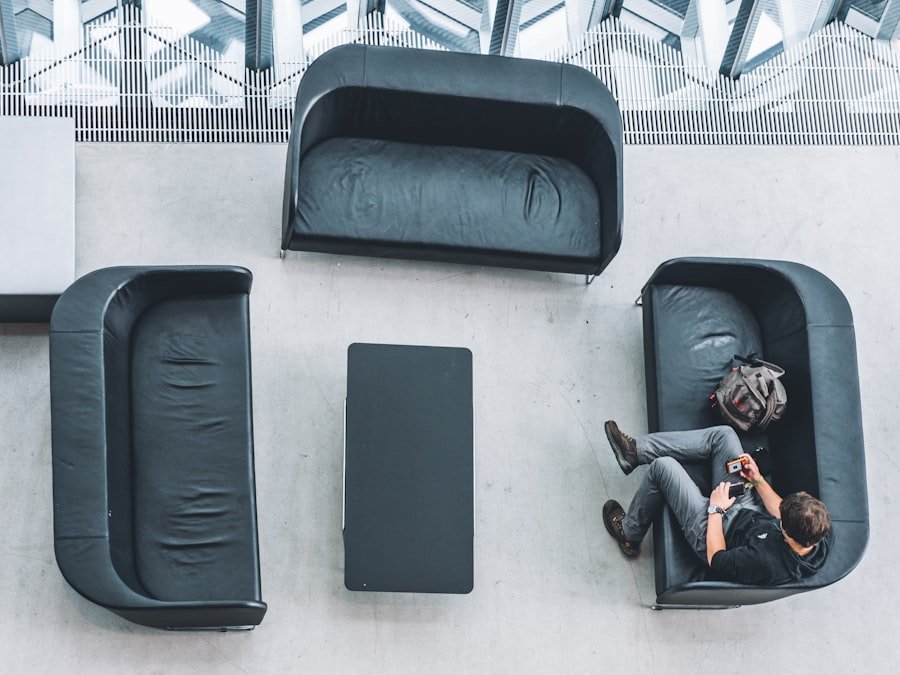Now Reading: Preventing VR Motion Sickness: Tips & Tricks
-
01
Preventing VR Motion Sickness: Tips & Tricks
Preventing VR Motion Sickness: Tips & Tricks

As I delve into the world of virtual reality (VR), I often find myself grappling with a phenomenon known as VR motion sickness. This condition can be quite disorienting, as it mimics the symptoms of traditional motion sickness, such as dizziness, nausea, and even sweating. The root cause of this discomfort lies in the disconnect between what my eyes perceive and what my inner ear senses.
When I don a VR headset, my visual system is immersed in a digital environment that may not align with my physical movements. This sensory mismatch can lead to a confusing experience, leaving me feeling queasy and disoriented. Understanding the mechanics behind VR motion sickness is crucial for anyone looking to enjoy this technology without the unpleasant side effects.
My brain relies on a harmonious relationship between visual input and vestibular signals to maintain balance and orientation. However, when I engage in VR experiences that involve rapid movements or disorienting visuals, my brain struggles to reconcile these conflicting signals. This can result in a range of symptoms that can detract from the immersive experience that VR promises.
By acknowledging the factors that contribute to VR motion sickness, I can take proactive steps to mitigate its effects and enhance my overall enjoyment of virtual environments.
Key Takeaways
- VR motion sickness is caused by a disconnect between what the eyes see and what the body feels
- Choose VR equipment with high refresh rates and low latency to minimize motion sickness
- Set up your VR environment in a well-lit, spacious area with minimal obstacles
- Take regular breaks to rest your eyes and prevent VR motion sickness
- Use anti-motion sickness techniques such as ginger or acupressure wristbands to alleviate symptoms
Choosing the Right VR Equipment
Selecting the appropriate VR equipment is a pivotal step in my journey to minimize motion sickness. The market is flooded with various headsets and accessories, each offering unique features and capabilities. I’ve learned that some headsets are designed with advanced tracking technology that can significantly reduce the likelihood of motion sickness.
For instance, headsets with inside-out tracking systems tend to provide a more seamless experience, as they accurately track my movements in real-time, creating a more natural interaction with the virtual world. Additionally, I’ve discovered that the refresh rate and resolution of the headset play a significant role in my comfort level during VR sessions. A higher refresh rate ensures smoother visuals, which can help reduce the jarring sensations that often trigger motion sickness.
Furthermore, opting for a headset with a higher resolution allows for clearer images, making it easier for my brain to process the visual information without feeling overwhelmed. By carefully considering these factors when choosing my VR equipment, I can create a more enjoyable and less nauseating experience.
Setting Up Your VR Environment

Creating an optimal VR environment is another essential aspect of my VR experience that can influence the onset of motion sickness. I’ve found that having a dedicated space for VR not only enhances immersion but also minimizes potential hazards that could lead to accidents or discomfort. Ensuring that my play area is free from obstacles allows me to move freely without the fear of bumping into furniture or tripping over objects, which can be disorienting and contribute to feelings of nausea.
Moreover, I’ve learned that lighting plays a crucial role in my VR setup. A well-lit room can help reduce eye strain and enhance my overall comfort while using the headset. I prefer to use ambient lighting that doesn’t create harsh shadows or glare on the headset’s lenses.
Additionally, maintaining a comfortable temperature in my VR space is vital; overheating can exacerbate feelings of discomfort and contribute to motion sickness. By taking the time to set up my VR environment thoughtfully, I can create a more enjoyable and immersive experience.
Taking Breaks
In my quest to enjoy virtual reality without succumbing to motion sickness, I’ve come to appreciate the importance of taking breaks during my sessions. Engaging in VR for extended periods can overwhelm my senses and increase the likelihood of experiencing discomfort.
During these breaks, I take the opportunity to stretch and move around, which helps alleviate any tension that may have built up during my VR experience. I also find it beneficial to focus on my breathing and ground myself in the physical world for a few moments. This practice not only helps me recover from any feelings of nausea but also enhances my overall enjoyment when I return to the virtual environment.
By incorporating breaks into my VR sessions, I can prolong my enjoyment while minimizing the risk of motion sickness.
Using Anti-Motion Sickness Techniques
As I navigate the challenges of VR motion sickness, I’ve discovered several anti-motion sickness techniques that have proven effective in alleviating discomfort. One method that has worked well for me is focusing on a fixed point within the virtual environment. By concentrating on a stable object or element in the scene, I can help anchor my visual perception and reduce the disorienting effects of rapid movement.
Another technique I’ve found helpful is adjusting my movement speed within the virtual world. Many VR applications allow me to customize settings related to locomotion, enabling me to move at a slower pace. This gradual approach gives my brain more time to process visual information and reduces the likelihood of experiencing nausea.
Additionally, using teleportation mechanics instead of continuous movement has been beneficial; this method allows me to navigate without the disorienting sensation of motion, making for a more comfortable experience overall.
Adjusting VR Settings

Fine-tuning the settings on my VR headset is another crucial step in combating motion sickness. Each headset comes equipped with various options that can significantly impact my comfort level during use. For instance, adjusting the field of view (FOV) can help create a more natural visual experience.
A narrower FOV may reduce peripheral distractions and help me focus on the central action without feeling overwhelmed. Furthermore, I’ve learned that enabling features such as “comfort mode” or “vignetting” can also be beneficial. These settings often darken the edges of my visual field during movement, which can help minimize feelings of nausea by reducing peripheral motion cues.
By taking the time to explore and adjust these settings according to my preferences, I can create an environment that feels more comfortable and enjoyable while using VR.
Practicing Relaxation Techniques
Incorporating relaxation techniques into my routine has proven invaluable in managing VR motion sickness. When I feel tension building up during a session, I take a moment to practice deep breathing exercises. Focusing on slow, deliberate breaths helps calm my nervous system and reduces feelings of anxiety that may exacerbate nausea.
This simple yet effective technique allows me to regain control over my body’s response to discomfort. Additionally, I’ve found mindfulness practices beneficial when engaging with virtual environments. By staying present and aware of my physical sensations while immersed in VR, I can better manage any discomfort that arises.
Techniques such as progressive muscle relaxation—where I consciously tense and then relax different muscle groups—help me release built-up tension and enhance my overall comfort during sessions.
Staying Hydrated
Staying hydrated is another essential aspect of managing VR motion sickness that I’ve come to prioritize. Dehydration can exacerbate feelings of nausea and dizziness, making it crucial for me to drink enough water before and during my VR sessions. I’ve made it a habit to keep a water bottle nearby while using my headset, ensuring that I stay refreshed and alert throughout my experience.
Moreover, I’ve noticed that maintaining proper hydration levels helps improve my overall focus and cognitive function while immersed in virtual environments. When I’m well-hydrated, I feel more energized and less prone to fatigue, which can contribute to discomfort during extended sessions. By making hydration a priority, I can enhance both my physical well-being and enjoyment of VR.
Avoiding Triggering Foods and Beverages
In addition to staying hydrated, I’ve learned that being mindful of what I consume before engaging in VR is essential for minimizing motion sickness symptoms. Certain foods and beverages can trigger discomfort or exacerbate feelings of nausea. For instance, heavy meals or greasy foods tend to sit heavily in my stomach and can lead to an unpleasant experience while using VR.
I’ve also discovered that caffeinated beverages can have mixed effects; while they may provide an initial energy boost, they can also lead to jitters or increased anxiety levels—both of which are not conducive to a comfortable VR experience. Instead, I opt for light snacks such as fruits or nuts before diving into virtual worlds, ensuring that my body feels balanced and ready for immersion.
Engaging in VR Motion Sickness Exercises
To further combat motion sickness while enjoying virtual reality, I’ve started incorporating specific exercises designed to acclimate my body to the sensations experienced in VR environments. These exercises often involve gradual exposure to movement while focusing on stabilizing techniques. For example, practicing simple head movements while seated helps train my vestibular system to adapt more effectively when using a headset.
Additionally, engaging in balance exercises outside of VR has proven beneficial as well. Activities such as yoga or tai chi not only improve my physical balance but also enhance my body’s awareness of spatial orientation—skills that translate well into virtual environments. By dedicating time to these exercises regularly, I’m better equipped to handle the unique challenges posed by VR motion sickness.
Seeking Professional Help if Needed
Despite all these strategies I’ve implemented, there may still be instances where motion sickness persists or becomes overwhelming. In such cases, seeking professional help is a wise course of action. Consulting with healthcare professionals who specialize in vestibular disorders or motion sickness can provide valuable insights tailored specifically to my needs.
These experts may recommend additional techniques or therapies designed to address underlying issues contributing to my discomfort in virtual environments. Whether it’s through physical therapy or cognitive-behavioral strategies aimed at desensitization, professional guidance can offer new perspectives on managing motion sickness effectively. By recognizing when it’s time to seek help, I empower myself to enjoy virtual reality fully without being hindered by discomfort.
In conclusion, navigating the world of virtual reality while managing motion sickness requires a multifaceted approach that encompasses understanding its causes, choosing appropriate equipment, setting up an optimal environment, taking breaks, utilizing anti-motion sickness techniques, adjusting settings, practicing relaxation methods, staying hydrated, avoiding triggering foods, engaging in specific exercises, and seeking professional help when necessary. By implementing these strategies into my routine, I’ve been able to enhance my enjoyment of virtual reality while minimizing discomfort—a journey that continues as technology evolves and new experiences await me in this exciting digital realm.
If you’re interested in the mental wellness benefits of gaming, you should check out the article Gaming: My Therapy for Mental Wellness. It explores how gaming can be a form of therapy for some individuals.
FAQs
What is motion sickness in VR?
Motion sickness in VR is a condition where a person experiences nausea, dizziness, and discomfort while using virtual reality technology. It is caused by a disconnect between what the eyes see in the virtual environment and the body’s physical movement.
What are the symptoms of motion sickness in VR?
Symptoms of motion sickness in VR can include nausea, dizziness, sweating, headache, and general discomfort. Some people may also experience vomiting and disorientation.
What are some tips to avoid motion sickness in VR?
To avoid motion sickness in VR, it is recommended to take regular breaks, focus on a stationary object, avoid sudden movements, and adjust the VR settings to reduce motion blur and increase frame rates. It is also important to ensure proper ventilation and hydration while using VR.
Can certain VR games or experiences trigger motion sickness more than others?
Yes, certain VR games or experiences that involve rapid movements, quick camera rotations, or intense visual effects are more likely to trigger motion sickness. It is important to choose VR content that is comfortable and suitable for individual tolerance levels.
Are there any specific VR headsets or devices that are designed to reduce motion sickness?
Some VR headsets and devices are designed with features such as adjustable lenses, higher refresh rates, and improved tracking systems to reduce motion sickness. It is important to research and choose a VR headset that is known for its comfort and motion sickness mitigation features.



























